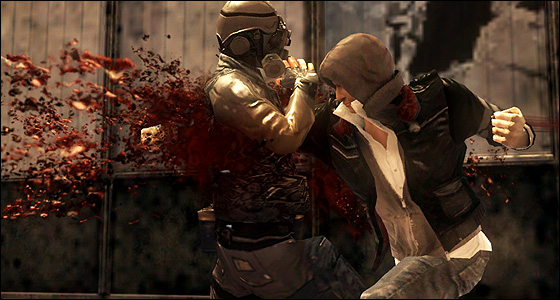R18+ Classification Ramblings
February 1st, 2009
There’s been a bit of a stir in Australia over the past for too long about the R18+ classification issue. If you hadn’t heard – and let’s be honest, since when did you care about Australia? – there is no R18+ classification down under. Instead games with extreme levels of content are pushed through a convoluted process of moderation while we sit on the sidelines, looking abroad at our neighbours, hands clasped.
Obviously, this has fired up our gaming community and much labouring has been done in an attempt to pressure politicians for change. But still, we are an attorney general away from freedom, and the debate goes on. While it’s obviously a hot point of discussion over here, I personally don’t really care much for it. Having an R18+ rating is clearly the “right” thing to do, and it will happen…eventually, so let’s not cry fowl eh? In the meantime the level of moderation has almost no affect on what I play. So how ’bout we all just enjoy some games? I’m all for the good of this medium of entertainment but some people over here seriously don’t know when to stop complaining and just enjoy the weather.
There are two are interesting points of discussion residing at opposite ends of the argument that I wish to mention. I guess I had to do my patriotic deed and talk about this some, at least I’m not whining.
Volume
Something that I think we fail to realize as a mass of long term, dedicated players is the frequency of violence that occurs throughout play. In a movie, a violent event occurs and then passes; movies are static like that. A game in comparison is variable. As a player, you can partake in many violent acts more frequently with the exception of pre-scripted events (say a torture scene).
Violence is the conflict which acts the catalyst for gameplay. How does one usually complete a game set in a first person perspective, with the protagonist holding a gun in view? More often than not the player moves from one point to another, making use of the cannon fodder that attempts to prevent you from meeting that goal of reaching the other point.

Because of the nature of video games, players often need to complete a set task multiple times in order to reach an end. A shooting game involves shooting people, an RPG involves battling enemies to level up, a platforming games involves a character traversing platforms to reach a goal and so forth. Each of these tasks are carried out at a high frequency and we know so by the very way we categorize game genres. Since games are a medium reliant on repetitive tasks and as those tasks are often associated with conflict – and conflict usually goes hand in hand with violence unfortunately – violent games by nature have a much higher frequency than media with static violence. When discussing game classification, this should be considered.
Realism
On the flip side video games can never match the realism of live action. Although depending on the subject matter video games possess the power to create more believable violent themes. The use of 3D special effects and animation in film is a fantastic discussion point on this subject. 3D modeling composes gruesome creatures, fake blood animation and so forth. While games use these effects, video games are man-made digital creations and hence can never achieve a true realistic character to match reality itself. So again realism is another spanner for either case.
Video Game Retailers and Game Classification Attitudes
March 24th, 2008
 Recently I have been thinking about video game classification in relation to the general attitudes of game retailers. You see this all came about a few weeks ago when I saw the pictured image in a Dick Smiths catalogue (Dick Smiths = Australian electronics retailer). This image is of a child holding up an Xbox 360 and two mature rated games; Gears of War and Halo 3.
Recently I have been thinking about video game classification in relation to the general attitudes of game retailers. You see this all came about a few weeks ago when I saw the pictured image in a Dick Smiths catalogue (Dick Smiths = Australian electronics retailer). This image is of a child holding up an Xbox 360 and two mature rated games; Gears of War and Halo 3.
Obviously there is a problem here in that the kid is promoting two MA5+ games and in Australia selling MA15+ games to minors is an offense yet Dick Smiths clearly aren’t worried about that. This is pretty minor oversight, I know but I believe that it symbolizes the general attitude that retailers have towards this issue.
Stepping back from Dick Smiths for a while I want to use another example. For my last job I was working at one of Australia’s most successful retailers; Myer. Through my 6 months of work for the company (in the electrical department) nothing was ever brought up o the issue of video game classification. I was never instructed of who I could and couldn’t sell a game to instead it was all left down to assumptions and personal opinion. The same goes for my job before that at Harris Scarfes in which we sold a few cheap DVD compilations.
All video game retailers clearly believe in the classification system as their games display the classifications and in many cases classification information is visible in store, online and in catalogues. Where the problem lies is with the staff and staff training, over the years I have seen and in fact probably have myself been involved in the selling of mature rated games to minors. In every case the staff sell the game without fuss and the issue of classification is ever raised. From my point of view this is all a problem of attitude.
So Why Do I Care?
When I was a kid I watched R18+ movies and played imported R18+ games and I think that I turned out okay. So why do I care? Simple; reputation. As I previously posted it is important for the media and wider community to look favourably at video games so that we can reach the end goal of being regarded as equals with film and literature.
Every time the media screen an (ill-informed) segment related to video game violence it is our industry which is looked down upon. It is another pitfall in the way. The only thing that we can do as an industry is abide by the laws and from there it is up to the consumer.
Unfortunately I don’t see businesses changing, where there is profit to be made why worry about selling a child one of these games?



 Game Design Companion: A Critical Analysis of Wario Land 4 - $7.99
Game Design Companion: A Critical Analysis of Wario Land 4 - $7.99 Level Design: Processes and Experiences
Level Design: Processes and Experiences Speed Boost: The Hidden Secrets Behind Arcade Racing Design - $5.99
Speed Boost: The Hidden Secrets Behind Arcade Racing Design - $5.99 Adventures in Games Analysis: Volume I - $5.99
Adventures in Games Analysis: Volume I - $5.99







